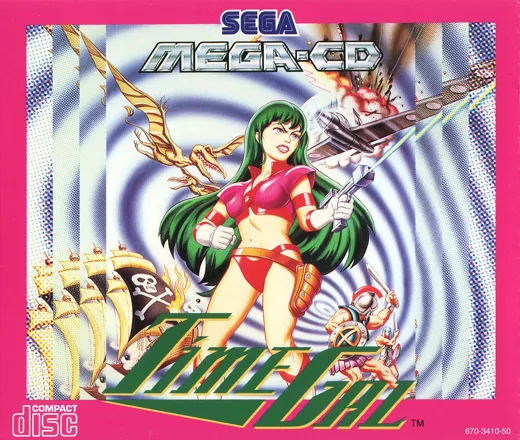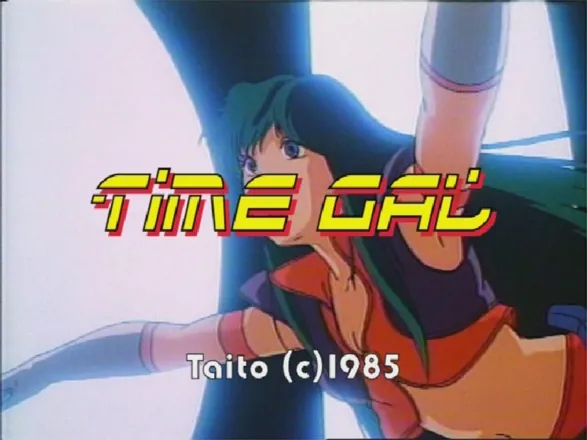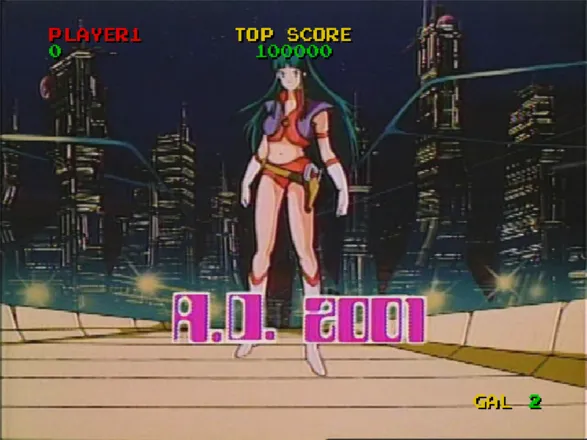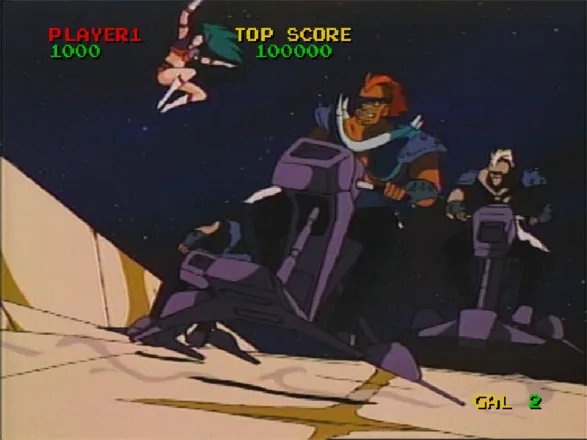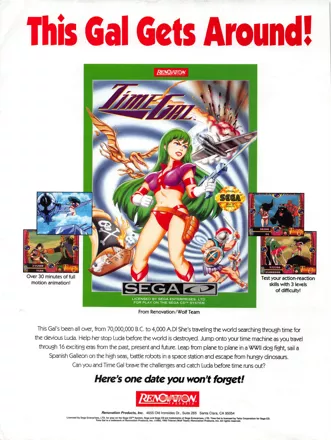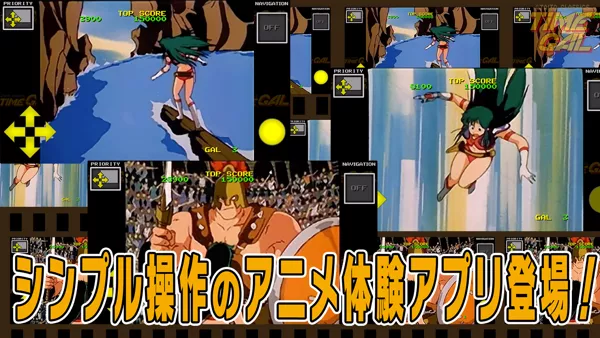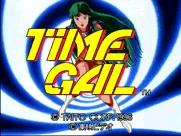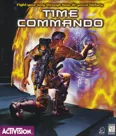Time Gal
Description
The year is 4001. The evil Luna has stolen a time machine and plans to use it to take over the world. You are the Time Gal, a skillful and pretty scientist, and your mission is to chase Luna through different time periods, to get the time machine back, and to save the world.
Created during the first age of "full motion" style, Time Gal is a conversion of an early arcade title. You watch animations of your heroine while she travels through levels, and overcome obstacles by pushing the correct button at the right moment. You can change directions, jump, shoot, etc., but everything is controlled during the never-ending fluent motion of the Time Gal. At certain points the heroine stops the time, and you have three choices to choose from.
Spellings
- タイムギャル - Japanese spelling
- 타임걸 - Korean Hangeul spelling
Groups +
Screenshots
Promos
Credits (Arcade version)
10 People
| Game Design by | |
| Soft Program by | |
| Gal Created by | |
| Sound Director | |
| Director | |
| Character Designer | |
| Sound Effect | |
| Film Produced by |
|
| Presented by |
|
Reviews
Critics
Average score: 67% (based on 19 ratings)
Players
Average score: 3.8 out of 5 (based on 10 ratings with 1 reviews)
In The 1990s, Sega said, "Welcome To The Next Level" by taking us back to the 1980s..
The Good
In the early 1990s, the CD-ROM revolution was hitting both world of computer and video games. The final days of floppy disks and cartridges was coming upon consumers.
Just as the music industry had to say "goodbye" to records and cassette taps, the game industry was going to have to say "goodbye" to its old technology and, yes, "hello" to the huge storage capacity of CD discs.
Sega, which certainly had some amazing advertising campaigns in the 1990s, stepped its corporate toe into the CD-ROM pool with the tagline "Welcome To The Next Level".
Actually, Sega of Japan did the stepping, apparently without much feedback from their American branch, and the Sega CD (or Mega CD for PAL gamers) ending up frustrating gamers, especially Sega fans, more so then anything else.
Remember that a computer disc or a video cartridge could not store too much memory. It was probably memory for gamers in the 1970s - 1980s, but the limitations meant that games the size a of a game -- including size of the game's world -- faces practical limitations.
Yes, a video cartridge can -- technically -- hold a very large game memory; 500 megabytes (the standard for a CD at the time). However, only one company tried to do this commercially? Why
Well, the only way to make a profit with a video cartridge of that size, was to price the game at over a hundred dollars. Not too many consumers are going to spend three hundred dollars on a single video game. Not many consumers could afford to, especially in the era of Reagan Economics.
The most part a video cartridge had anywhere between 1 - 25 megabytes of memory stored in it. Most computer discs had less storage capacity, which meant that games often required more then one disc to install or even play.
OK, so the limited storage capacity of a video cartridge or a computer disk, made it impractical produce the type of sand box or open world concepts games that we see today.
The limited storage capacity also meant that games could not have full motion, extensive dialogue read by actors or other digital audio and video effects that been limited to some coin-op arcade games and a few laser disc games.
The Sega CD -- for all its many faults -- could potentially do much large, interactive game worlds and, yes, offer consumers the type of features normally seen in coin-op arcade games, especially laser disc arcade games.
Bigger means better, right? What could possible, possible go wrong with the Next Level?
Time Gal for the Sega CD was one of the first games released for the CD-ROM game system. In fact most of the early games released for the Sega CD were games that featured extensive animation or full motion video.
Initially, Time Gal did look and sound simply revolutionary on the Sega CD. Remember that it was designed and marketed for consumers who grown up with games having to fit on computer discs or video cartridges.
The Sega CD was probably the first CD-ROM game system that lots of kids -- at least in America -- heard about and played. NEC was first, but not too important.
Far fewer American consumers were familiar with the NEC CD-ROM system. It was pretty much the third party in the American video game market. It had a distant third place in terms of national support and visibility, not unlike, say, a third party candidate in American politics, like Ralph Nader.
While PC and Mac computers were also moving on into the CD-ROM format, the price of a decent CD-ROM computer was still bigger then most consumers wallets.
To make a long story short (too late?) if you were an American consumer in the early 1990s - mid 1990s, the Sega CD was more affordable then a good CD-ROM computer.
For the first time, American consumers -- on a fairly large scale -- got to play a video game like Time Gal in the comfort of their own living room or even bedroom. They didn't need to find a laser disc arcade machine, and they didn't need to pay a thousand dollars (or so) to get a decent CD-ROM computer.
It may not seem like much today, but seeing Time Gal on the Sega CD was amazing. Never before had most gamers of my generation actually played a game that looked, sounded and moved like a cartoon.
The Bad
Once the initial awe and excitement was over, two things became rather clear in the minds of consumers who had eagerly bought into the Sega CD hype.
First off all, Time Gal was an adaption of an older game (something about a 1990s "Next Level" ad campaign does not scream "Lets All Go Back To The 1980s"). Heck, it was not even a perfect adaption of an older arcade game.
The Sega CD graphic's hardware was limited to displaying 64 colors on-screen, out of 512 total colors. Many of the early games to use full motion video tended to only use 32 colors on-screen.
Laser disc games and indeed popular game systems of the time did not operate under such limitations.
The nice-looking Japanese animation in Time Gal had to be edited to fit the hardware limitations of the Sega CD. It could not be full-screen, full motion video and the video quality itself could equal seeing a animated film on TV.
Second off all, the level of interactivity in Time Gal and similar cases was pretty low.
Laser disc games could look and sound pretty, but game play was limited to figuring out which button to press at the precise time in order keep the animation going.
Full motion video games using live actions, could also look and sound pretty, but game play was often limited to switching between a few 'cameras' -- at the precise moment - in order to keep the cheesy, B-movie going.
The Bottom Line
Time Gal for the Sega CD does look and sound pretty. It is one of the first games released for the CD-ROM system and shows off the increased storage capacity of the then-new media. It suffers from not being a perfect adaption of an older game. The entire genre of full motion video games suffers from not offering the sort of interactivity that gamers wanted, but had to wait until games like Grand Theft Auto, Fable and the Elders Scroll were released.
SEGA CD · by ETJB (428) · 2014
Trivia
Cameo
The main character Reika also appears as a playable character in Castle of Shikigami III for the Wii and XBox 360.
Version differences
In the European and Japanese versions, Time Gal has slightly less clothing.
Information also contributed by Mark Ennis.
Analytics
Upgrade to MobyPro to view research rankings!
Related Sites +
-
Video review of the system (WARNING: Language)
The Angry Video Game Nerd, James Rolfe, reviews the Sega CD and gives brief reviews of some games, including Time Gal for Sega CD.
Identifiers +
Contribute
Are you familiar with this game? Help document and preserve this entry in video game history! If your contribution is approved, you will earn points and be credited as a contributor.
Contributors to this Entry
Game added by Unicorn Lynx.
iPhone, iPad, Android added by Kam1Kaz3NL77. Windows added by HelloMrKearns. Macintosh added by Foxhack. Arcade added by Kohler 86. LaserActive added by Kabushi. MSX added by Игги Друге. Nintendo Switch added by Ms. Tea.
Additional contributors: Alaka, LepricahnsGold, Ms. Tea, Rad Spencer.
Game added May 29, 2004. Last modified January 27, 2024.
